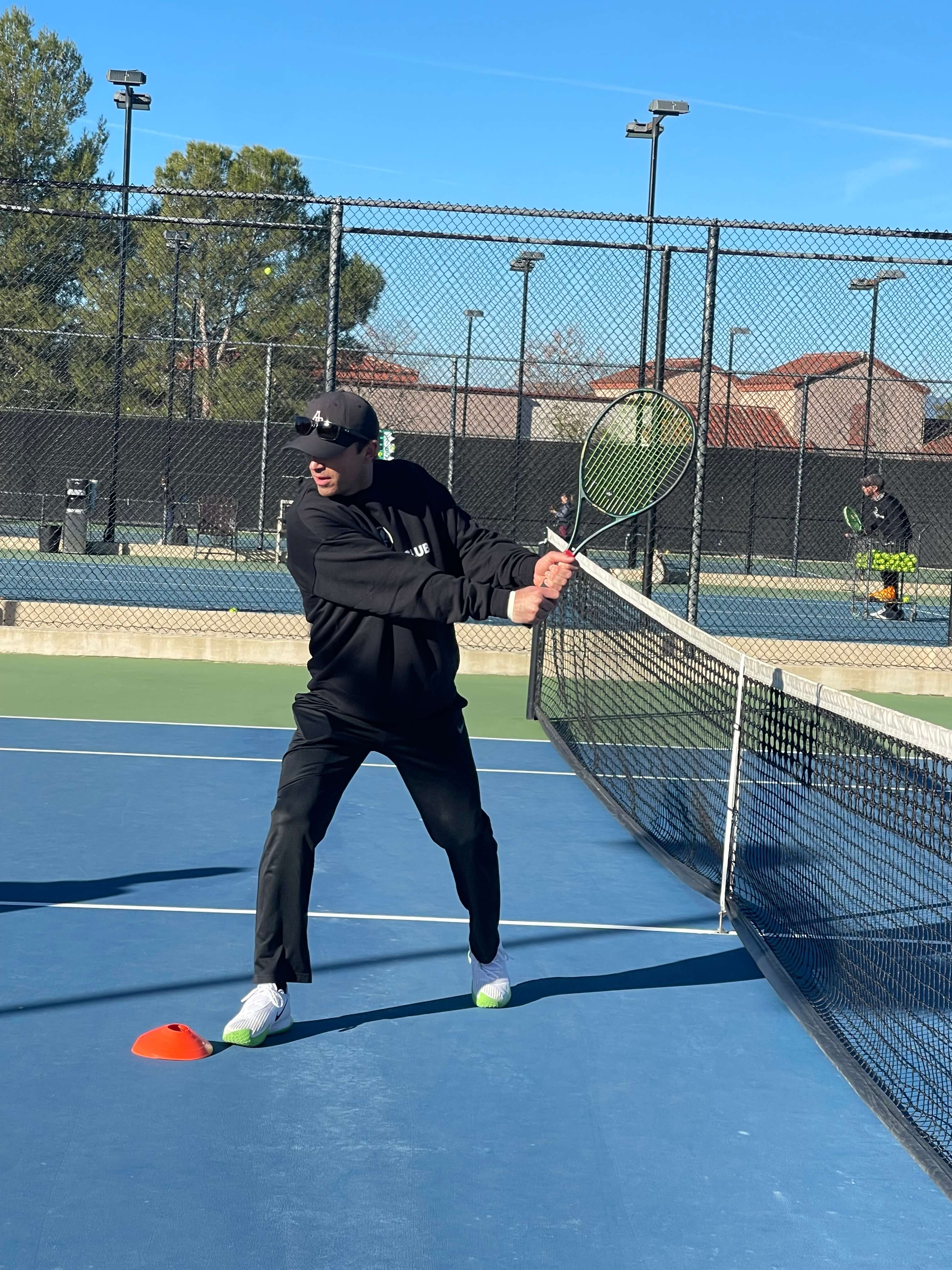Muscular Imbalance — How it is affecting your game and what you can do about it
September 6th, 2024 | 5 min. read

Whether you are an avid tennis player, pickleball player, swimmer, or runner, you likely suffer from muscular imbalances.
Muscular imbalances can be obvious. In the case of tennis players, the dominant side is stronger, more developed than the non-dominant side. However, imbalances may not always be obvious. These imbalances leave you vulnerable to injury.
Fixing muscular imbalances through cross-training, stretching, and weight-bearing activities is essential for competitive athletes, middle-aged & senior athletes, and anyone who wants to work out consistently and avoid injury.
The Paseo Club is a social club that supports members’ health and fitness. We offer over 60 weekly classes to help you stay active and move safely. Our personal trainers can teach you how to correct imbalances so you can enjoy being fit at all stages of your life.
In this article, you will learn what muscular imbalance is, the signs of muscular imbalance, how it affects your athletic performance, and what you can do about it.
.png?width=390&height=338&name=crop_%20comp-%20Edited%20(1).png) What is muscular balance?
What is muscular balance?
To explain what muscular imbalance is, you must first understand what muscular balance is. Muscular balance is the ability of muscles to move together efficiently and freely.
Consider a traditional weight: a weight is level when the objects on both sides produce the same force. But what happens when one side weighs more than the other? We say there is an imbalance and muscles work together similarly. Muscles coordinate their force potential to move around and support their receptive joint.
How do I see muscular imbalances?
The body can be divided into comparable cross-sections. The two main types of cross-sections are across the body and around a joint.
Across the body
- Front to back (anterior/posterior)
- Lower body to upper body (inferior/superior)
- Middle of the body to the outer parts (medial/lateral)
- Cross-lateral sectioning of the body (going from the left foot to the right hand and vice versa)
Around a joint
The muscles surrounding a joint work with opposing forces to stabilize the joint and bones. If one or more of these muscles becomes too weak, strong, loose, or tight, you will experience instability, which affects resistance to & production of force and range of motion.
 How is muscular imbalance identified?
How is muscular imbalance identified?
Many factors contribute to muscular imbalance, but the primary characteristics are length (shortened/overactive) and strength (lengthened/underactive).
You can observe muscle imbalances in different ways.
- Visual imbalances can be perceived when one muscle group is larger than another. This is an obvious observation in professional tennis players, which becomes the reason for injury in players who neglect their imbalances.
- A body scan provides an objective way to assess muscular balance. Dexa-scan or InBody scan are the most common choices. These technologies analyze your body’s muscle mass distribution, and present muscular mass in terms of pounds and percentage of full lean body mass.
- A Dynamic Movement Assessment (DMA) is a research-based examination. It contains a set of essential athletic movements to identify faulty or uncontrolled movement patterns and quantify them. This requires a professionally trained coach who knows what to look for in your form.
What are some activities or lifestyle choices that contribute to muscular imbalance?
Muscular imbalances can occur for several reasons. Sometimes imbalances are because of an issue with your sport, while other times they are caused by inactivity.
Sports that require a dominant sideTennis
Soccer
Pickleball
Volleyball
Basketball
Baseball/softball
And many more…
Activities that require repetitive action
Swimming
Gymnastics
Exercising only one set of muscles or areas of the body
Rowers
Cyclists
Long-distance runners
Training at the gym and omitting legs, upper body, core, etc.
Passivity or inactivity
Poor static posture
Sitting at a desk for work
Being sedentary and not physically active
Protecting an injury
Exercising or playing a sport with an unhealed injury leads to overcompensation and imbalance in the opposing side or muscles of the body.
 1. Sports that require a dominant side
1. Sports that require a dominant side
- Tennis
- Soccer
- Pickleball
- Volleyball
- Basketball
- Baseball/softball
- And many more…
2. Activities that require repetitive action
- Swimming
- Gymnastics
3. Exercising only one set of muscles or areas of the body
- Rowers
- Cyclists
- Long-distance runners
- Training at the gym and omitting legs, upper body, core, etc.
4. Passivity or inactivity
- Poor static posture
- Sitting at a desk for work
- Being sedentary and not physically active
5. Protecting an injury
- Exercising or playing a sport with an unhealed injury leads to overcompensation and imbalance in the opposing side or muscles of the body.
Tennis players often struggle with muscular imbalance. They typically have a stronger, hypertrophied, dominant arm & shoulder and a weaker, thinner non-dominant side.
Players with a two-handed backhand have overactive anterior deltoids (front sides of the shoulder) and over-lengthened and weak posterior deltoids (back sides of the shoulder). This dynamic is also observed in people who work at desks for long periods.
The reality is that anything and everything has the potential to cause muscular imbalance, it’s just a matter of how to correct it.
 How do muscle imbalances affect our bodies and athletic performance?
How do muscle imbalances affect our bodies and athletic performance?
There is extensive research on how muscular imbalance affects athletes. Much of the exploration is regarding injury and pain — and the proof is extensive. However, some of the studies also look at athletic performance.
Injuries
Dr. Jamil R. Neme points towards muscular imbalance as the critical source for muscle sprains, strains, or osseous (bone) abnormalities. These (mostly) preventable injuries sideline athletes, causing lengthy recoveries and costly rehab programs. In the worst case, an injury can be so extreme the athlete cannot return to their sport.
Dr. Carolyn A Emery found a cyclical concern between poor endurance, lack of preseason training, and even psychosocial factors that contribute to the development of muscular imbalances and injury.
Scientists in a third study researched the relationship between the quadriceps and the hamstrings in football players. They discovered that a simple strength imbalance between the two muscles is enough to put the entire football team at risk for knee injury and tendon damage.
Tennis elbow is linked to upper arm muscle underdevelopment and is an issue of “fear-avoidance” according to the researcher.
Pain
A study from the Department of Physical Medicine and Rehabilitation at the NJ Medical School reported a link between chronic low back pain, hip imbalances, and poor core strength in athletes.
Performance
Side-to-side (lateral) muscular imbalance is shown to impact jumping, sprinting, team, and endurance sports performance.
 How can muscle imbalances be corrected?
How can muscle imbalances be corrected?
There are four steps to correcting muscular imbalances.
- The most important step is to work preventatively, thereby minimizing the chance of injury. Perform strength training and mobility exercises several times weekly to develop symmetrical strength, a healthy range of motion, and to minimize imbalances.
- Learn about your musculature through some form of assessment.
- If you have muscular imbalances (as most people do to some degree), individualize strength training and stretching programs to counteract the further development of muscular imbalance and resolve any preexisting imbalance.
- Incorporate counterbalancing activities to help equalize muscle use, such as rowing with tennis or swimming with running. You can cross-train simultaneously with your primary activity or seasonally. An example of a seasonal round is swimming in the summer, playing tennis in the fall, skiing in the winter, and running in the spring.
Optimizing your health through muscular balance
It is not unusual to favor certain areas of the body when you train, play sports, and even sit and stand. But over time, these tendencies can lead to troublesome weaknesses that leave us vulnerable to pain, reduced athletic performance, and injury.
Do not let these symptoms be the motivator to correct imbalances in your body. Instead, work proactively to cross-train, strength train, and stretch to optimize your body’s well-being and capacity.
The Paseo Club has several resources to help you improve your muscular balance. There are over 60 fitness classes available to you each week. Pilates and yoga are great options for mobilization. Check out Cardio Strength, Tribe, Women’s Strength Training, or HIIT in 30 minutes. You can also meet with a personal trainer to develop a training plan based on your specific needs.
Fitness Trainer Daniel Peterson-Beliakoff offers assisted stretching and corrective exercise sessions to help you get more mobility and feel less pain. He will also help you develop a stretching program you can follow to maintain your gains.
The Paseo Club is your health, fitness, and social engagement destination. Enjoy our exercise facilities, manicured tennis and pickleball courts, and junior Olympic pool. We offer amenities such as childcare, a spa, and dining so you and your family can relax and enjoy yourself. Become a member today and start your Paseo lifestyle.
Topics:

